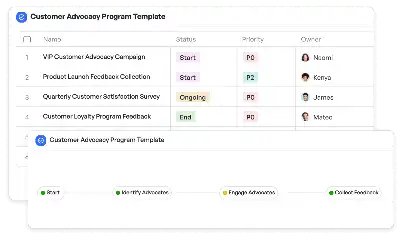Multi-Repository Dependency Graph
Achieve project success with the Multi-Repository Dependency Graph today!

What is Multi-Repository Dependency Graph?
A Multi-Repository Dependency Graph is a visual representation of dependencies across multiple repositories in a software development environment. It is crucial for understanding how different repositories interact, especially in complex systems involving microservices, libraries, and shared resources. By mapping these dependencies, teams can identify potential bottlenecks, avoid conflicts, and ensure seamless integration. For instance, in a microservices architecture, a Multi-Repository Dependency Graph helps developers visualize service interconnections, enabling better planning and execution of updates or changes. This tool is indispensable for large-scale projects where multiple teams work on interconnected repositories, ensuring that changes in one repository do not inadvertently disrupt others.
Try this template now
Who is this Multi-Repository Dependency Graph Template for?
The Multi-Repository Dependency Graph template is designed for software development teams, DevOps engineers, and project managers who oversee complex systems with multiple repositories. Typical users include microservices architects, who need to understand service dependencies; DevOps teams, who manage CI/CD pipelines; and quality assurance teams, who ensure compatibility across repositories. It is also valuable for open-source contributors working on projects with multiple dependencies, as it provides a clear overview of how their contributions fit into the larger system. This template is ideal for anyone looking to streamline collaboration and maintain system integrity in multi-repository environments.

Try this template now
Why use this Multi-Repository Dependency Graph?
Managing dependencies across multiple repositories can be challenging, especially when dealing with frequent updates, versioning conflicts, and integration issues. The Multi-Repository Dependency Graph addresses these pain points by providing a clear, visual representation of all dependencies. This helps teams identify and resolve conflicts early, plan updates more effectively, and ensure compatibility across repositories. For example, in a CI/CD pipeline, the graph can highlight potential bottlenecks, enabling teams to optimize workflows. Additionally, it aids in risk assessment by showing how changes in one repository might impact others, making it an essential tool for maintaining system stability and reliability.

Try this template now
Get Started with the Multi-Repository Dependency Graph
Follow these simple steps to get started with Meegle templates:
1. Click 'Get this Free Template Now' to sign up for Meegle.
2. After signing up, you will be redirected to the Multi-Repository Dependency Graph. Click 'Use this Template' to create a version of this template in your workspace.
3. Customize the workflow and fields of the template to suit your specific needs.
4. Start using the template and experience the full potential of Meegle!
Try this template now
Free forever for teams up to 20!
The world’s #1 visualized project management tool
Powered by the next gen visual workflow engine




